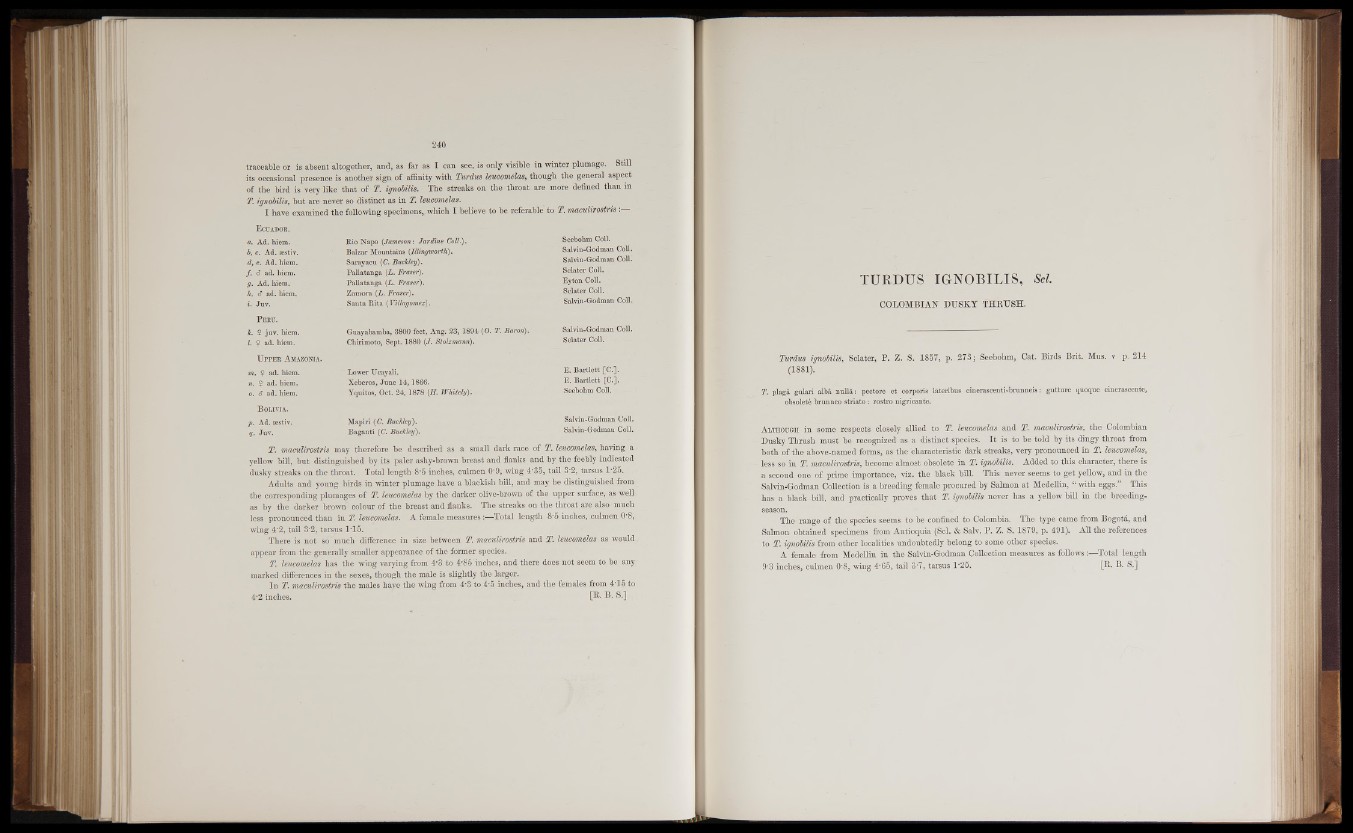
traceable or is absent altogether, and, as far as I can see, is only visible in winter plumage. Still
its occasional presence is another sign of affinity with Turdus leucomelas, though the general aspect
of the bird is very like that of T. ignobilis. The streaks on the throat axe more defined than in
T. ignobilis, but are never so distinct as in T. leucomelas.
I have examined the following specimens, which I believe to be referable to T. maculirostris:
E cuador.
a. Ad. hiem.
b, c. Ad. sestiv.
d, e. Ad. hiem.
f . 6 ad. hiem.
g . Ad. hiem.
h. <$ ad. hiem.
*. Juv.
P eru.
k. 2 juv. hiem.
I. 9 ad. hiem.
U pper Amazonia.
m. $ ad. hiem.
n. 9 ad. hiem.
o. 6 adì hiem.
B olivia.
p . Ad. sestiv.
g. Juv.
Rio Napo (Jameson: J a r dine Coll.).
Balzar Mountains (Illingworth).
Sarayacu (C. Buckley).
Pallatanga (L. Fraser).
Pallatanga (L. Fraser).
Zamora (L. Fraser).
Santa Rita ( Villagomez).
Guayabamba, 3800 feet, Aug. 23, 1894 (0 . T. Baron).
Chirimoto, Sept. 1880 (J. Stolzmann).
Lower Ucayali.
Xeberos, June 1 4 ,1866.
Yquitos, Oct. 24, 1878 (H. Whitely):
Mapiri (C. Buckley).
Baganti (C. Buckley).
Seebohm Coll.
Salvin-Godman Coll.
Salvin-Godman Colli
Sclater Coll.
Eyton Coll..
Sclater Coll.
Salvin-Godman Coll.
Salvin-Godman Coll.
Sclater Coll.
E. Bartlett [C.].
E. Bartlett [C.].
Seebohm Coll.
Salvin-Godman Coll.
Salvin-Godman Coll.
T. maculirostris may therefore be described as a small dark race of T. leucomelas, having a
yellow bill, but distinguished by its paler ashy-brown breast and flanks and by the feebly indicated
dusky streaks on the throat. Total length 8*5 inches, culmen O’9, wing 4*35, tail 3’2,.tarsus 1*25.
Adults and young birds in winter plumage have a blackish bill, and may be distinguished from
the corresponding plumages of T. leucomelas by the darker olive-brown of the upper surface, as well
as by the darker brown colour of the breast and flanks. The streaks on the throat are also much
less pronounced than in T. leucomelas. A female measures:—Total length 8-5 inches, culmen 0*8,
wing 4’2, tail 3’2, tarsus 1T5.
There , is not so much difference in size between T. maculirostris and T. leucomelas as would ,
appear from the generally smaller appearance of the former species.
T. leucomelas has the wing varying from 4‘3 to 4*85 inches, and there does not seem to be any
marked differences in the sexes, though the male is slightly the larger.
In T. maculirostris the males have the wing from 4’3 to 4*5 inches, and the females from 4*1.6 to
4’2 inches. | %]
TURDUS IGNOBILIS, Sci.
COLOMBIAN DTJSKY THRUSH.
Turdus ignobilis, Sclater, P. Z. S. 1857, p. 273 ; Seebohm, Cat. Birds Brit. Mus. v p, 214
(1881).
T. plaga gulari albà nullà: pectore et corporis lateribus cinerascenti-brunneis : gutture quoque cinerascente,
obsoletè brunneo striato : rostro nigricante.
A lthough in some respects closely allied to T. leucomelas and T. maculirostris, the Colombian
Dusky Thrush must be recognized as a distinct species. It is to be told by its dingy throat from
both of the above-named forms, as the characteristic dark streaks, very pronounced in T. leucomelas,
less so in T. maculirostris, become almost obsolète in T. ignobilis. Added to this character, there is
a second one of prime importance, viz. the black bill. This never seems to get yellow, and in the
Salvin-Godman Collection is a breeding female procured by Salmon at Medellin, “ with eggs.” This
has a black bill, and practically proves that T. ignobilis never has a yellow bill in the breeding-
season.
The range of the species seems to be confined to Colombia. The type came from Bogotá, and
Salmon obtained specimens from Antioquia (Sci. & Salv. P. Z. S. 1879, p. 491). All the references
to T. ignobilis from other localities undoubtedly belong to some other species.
A female from Medellin in the Salvin-Godman Collection measures as follows :—Total length
9*3 inches, culmen 0*8, wing 4*65, tail 3’7, tarsus 1*25. [B. B. S.]